Ford Maverick Vs Hyundai Santa Cruz Comparison: Same But Different

These two baby pickup trucks aren’t comparable.
Yes, we mean it: the 2022 Ford Maverick and Hyundai Santa Cruz both target two very different parts of the market. Yet it’s the comparison so many are clamoring for. The paucity of small pickups prior to these two, and their proximity in launch timing, has forced them together in our collective consciousness, like Armageddon and Deep Impact. Just instead of questionable-quality disaster films, we have two unibody trucklets.
Get a Quote on a New Ford Maverick or Hyundai Santa CruzThe Maverick is for those who miss the times a work truck was just that, but decry the gargantuan proportions of modern half-tons. Meanwhile, the Santa Cruz is funkier, more a product of the modern, lifestyle-focused times. Make the comparison to the cult classic Subaru Baja, and even Hyundai spokespeople nod in agreement.
Which one appeals to you has more to do with your intended use case than anything else. Our particular case study involved the top trims of both, put to light work in the city and surrounding suburbs. Here’s what we found out.
Interior and Cargo Space
Maverick: The Maverick’s interior design draws from the Bronco Sport it’s related to. Ease of operation is the name of the game, with a simple tiered dashboard layout making it clear where all the important controls are. Ford also pulls a design element from Hyundai’s sister Genesis brand: it isn’t afraid to use a bit of color. Blue plastic covers most surfaces, with a speckled light gray for contrast. The angular forms of the latter do a great job of making the interior visually interesting, even if its brittle to the touch. Mix in the brown accent pieces plus the blue-and-brown easy-clean ActiveX seats, and the Maverick perfectly illustrates the difference between a space feeling cheap and feeling affordable. I’m particularly fond of the “floating” door handles with the exposed screws, which make it easy to pull an open door shut, and leave space for enormous water bottles in the door pockets.
Driver and passenger are treated to flat yet comfortable seats. Support is good, though I’d appreciate better lower back support for longer drives. The seats are mounted at the right height for a lateral move in and out, a far cry from the climb modern full-size trucks require. Look ahead and the Maverick might as well be the Bronco Sport, with the same clear sight lines over its square hood.
Front headroom is quite generous, with a full 40.3 inches (1,024 mm) of the stuff. There’s even more legroom, so no complaints there. Back-seat passengers lose less than an inch (25 mm) of room for noggin bobbin’, and there’s still 36.9 inches (937 mm) of legroom. That isn’t just more than the Santa Cruz, it’s more than the larger Honda Ridgeline. Fold-up seats offer a handy in-cabin storage solution, too.
You’ll find a nearly-square 4.5-foot bed out back. It narrows down to 3.5 feet between the wheel wells, but Ford has included clever cutouts in the bed walls to split the hold up with 2x4s. There’s the requisite 120V/400W outlet back there, too.
Santa Cruz: As adventurous as the Santa Cruz’ exterior is, the interior is much more familiar. Basically, it’s a Tucson, with a few textile switches to distance the pickup from the crossover. That’s no bad thing: we rate the Tucson amongst the best in its class. The wraparound dashboard design, with its flowing waterfall shape and slimline vents, is a class act. There’s a whole lot of piano black however, and the touch-sensitive controls mean you can’t operate the climate controls without looking. Speaking of Robert Smith’s favorite color, it’d be Friday all the time for him in here. The texture on the dashboard breaks up the look, but we’d like more pops of color than the contrast stitching and pair of orange hash marks.
The Santa Cruz claws back some points with its supremely comfortable front seats. With a bit more contouring than the Blue Oval thrones, they’re more supportive—and more adjustable. The view out is good, though the angled C-pillar does eat into over-the-shoulder visibility.
The rakish Santa Cruz might be larger in most exterior dimensions, but the space race is a tight one. There’s more headroom in both rows, but you’ll sacrifice over inch of legroom up front, and 0.4 inches (10 mm) in the back. You’re unlikely to notice either, nor the bit of extra width afforded to Santa Cruz riders. In fact, the rising window line makes the second row feel tighter, even if it isn’t. As in the Mav, you can fold the rear seats up to reveal a shallow storage space.
The bed is much smaller in Hyundai’s lifestyle vehicle, and the wall is angled to boot. What’s more, the (standard in Canada) tonneau cover eats into the open space. Hyundai has gifted its little truck with some clever bed solutions, however. There’s the option to adjust the tailgate angle, so it’ll still accommodate larger items. There’s an in-bed trunk, too. Finally, there are corner steps in the bumper for easier access. The power outlet is just 150 watts to the Ford’s 400.
Bottom Line: This first category is already a big back-and-forth, and highlights the different priorities these two trucks have. The Maverick is all small-size workmanship, with a hard-wearing interior and straightforward bed setup. The Santa Cruz is a comparative luxury car inside, and its bed is more of a once-in-a-while proposition. It should prove handy for those who want to store undesirable stuff separate from the passenger space—say, smelly hockey equipment. But if you’re going to use the bed regularly, the Ford is the better choice, and as these are pickups, that earns it the first win of this face-off.
SEE ALSO: Subaru Outback vs Subaru Forester ComparisonTech and Features
Maverick: The Maverick runs Ford’s Sync 3 system. It’s a simple, straightforward system that should appeal to the no-frills crowd the Maverick is targeting. Apple CarPlay and Android Auto are both supported via wire, either USB-A or USB-C. The small cubby beside the screen is still pretty useless, and feels like a stop-gap (ha!) until the mid-cycle refresh brings in a bigger screen. Another smaller screen lives between the analog dials. This one is more up to date, with sharp graphics and a customizable layout.
Other goodies include automatic dual-zone climate control (standard on Lariat), heated front seats and steering wheel, and a power-adjustable driver’s seat. The heated elements are part of a luxury option package, available on both the XLT and this Lariat. You’ll also find two additional USB ports in the second row. The B&O sound system is reliable, but nothing outstanding.
Santa Cruz: A big, 10.25-inch infotainment screen provides clean, crisp visuals inside the Santa Cruz. It feels about a decade ahead of the setup in the Ford because, well, it almost is. It isn’t all sunshine and lollipops, however. As clean as the setup is, those touch-sensitive buttons make it so much harder to operate on the move. Wired CarPlay and AA are standard; it’s still strange wireless is only possible on the smaller 8.0-inch screen. The other 10.25-inch screen ahead of the driver is better. It’s similarly sharp, and provides plenty of useful information, all cycled with the touch of a button.
Also part of the Santa Cruz lineup are standard native navigation (which is quite good), a 360-degree camera, 64-color ambient lighting, and an eight-speaker Bose sound system. You also get ventilated front seats, something unavailable in the Ford. There are four USB-A ports throughout the cabin.
SEE ALSO: Toyota RAV4 vs Nissan Rogue ComparisonBottom Line: No contest here: the Santa Cruz has the better tech suite. Its infotainment is more feature-rich, its instrument panel is smooth, and it has more niceties. Even the lack of physical volume controls can’t detract from that.
Powertrain, Driving Feel, and Fuel Economy
Maverick: As standard, the Maverick comes in front-drive form, with a hybrid powertrain option. That’s a very interesting proposition, but for this face-off, we’ve got a drivetrain more inline with what the Hyundai is throwing down. We’re talking about the EcoBoost 2.0-liter four-cylinder, producing 250 horsepower and 277 pound-feet of torque. An eight-speed automatic sends that power to all four wheels.
This is the same engine found in a variety of Ford models, including the Bronco Sport and Escape. It’s not much different here: the four-pot puts in good work early in the rev range, ensuring the Mav moves without breaking a sweat. The auto ‘box shuffles quickly between gears, and the different drive modes alter its attitude appropriately. We wouldn’t call it quick, especially when tasked with a highway pass, but it feels wholly adequate for what is a small truck.
Of the two trucklets, its the Maverick that is the noisier one, both in town and (especially) on highways. That bluff shape is to blame, along with the chunkier treads of its tires. The ride can also get a little stiff, specifically from the rear, over rough tarmac. The loose-limbed feel of the Bronco Sport is gone, likely to prep the Mav for the maximum 4,000-pound towing capacity it comes with. Steering weight is light, and it’s still quick, so the Ford responds quickly and consistently to steering inputs. There’s none of the waywardness you might find in certain body-on-frame trucks. The brake pedal also earns strong marks in the notebook, easy to modulate and with a reassuring bite early on.
The most work the Mav put in during our time with it was transporting a bed full of lumber. We didn’t get a chance to test that towing limit, but the 4K towing package does include a seven-pin connector and additional transmission cooling.
Since the Maverick lacks the Bronco Sport 2.0’s more advanced AWD system, it posts better fuel economy figures. The EPA rates it at 22 mpg city and 29 mpg highway, for a combined 25 mpg figure. Canadian equivalents are 10.7, 8.1, and 9.6 L/100 km, respectively. The Maverick was thirstier during its short time with us, scoring 21.4 mpg (11.0 L/100 km).
Santa Cruz: Hyundai offers the Santa Cruz with the Tucson’s 2.5-liter naturally aspirated mill. Or you can get it with the turbocharged motor on test here, which is only available in the larger Santa Fe, or the sporty Sonata N Line. It makes an even 300 horsepower, plus a strong 311 lb-ft of torque. It matches the Ford’s eight forward gears too, though within a dual-clutch setup instead of a traditional automatic. It’ll happily drink down regular fuel, too.
That Sonata connection is more than just a shared engine. The Santa Cruz drives like a veritable hot hatch compared to the Maverick. Eager to rev, the 2.5-liter lays down the torque across its rev range, and the DCT shifts gears with a quickness unseen in the truck world. You can even switch it over to Sport mode and engage the wheel-mounted paddle shifters. There’s noticeably more power in any situation than in the Maverick, especially on on-ramps.
SEE ALSO: 2022 Subaru Outback Wilderness Review: First DriveOut on the highway, the Santa Cruz lets in barely more road noise than the Tucson with which it shares its platform. The 20-inch wheels had us pre-emptively wincing over big bumps, but the relatively soft suspension tuning allows the ‘Cruz to, well, cruise over most of them. It doesn’t lean over onto its sidewalls when presented with a corner, either. Conversely, the Santa Cruz stays surprisingly flat through the curves, feeling level and in control from behind the wheel. There’s not much in the way of weight to the steering—as expected—but it is quick and direct.
When properly equipped, the Santa Cruz will tow up to 5,000 pounds.
That power will cost you at the pumps, where the EPA quotes the Santa Cruz at 19 mpg city, 27 mpg highway, and 22 mpg combined. Canadian figures are 12.1, 8.6, and 10.6 L/100 km, respectively. Our time with the Santa Cruz was a little thirstier than its last head-to-head, but it still scored 20.5 mpg (11.5 L/100 km).
Bottom Line: The Maverick’s powertrain is good, but the Santa Cruz’ is gooder. If this were a face off between the base engines it’d be an easy win for the Ford; the Hyundai needs a hybrid setup yesterday. Thankfully one is coming soon.
Safety
Maverick: Even the base Maverick comes with automated emergency braking, auto high-beams, and the federally-mandated rearview camera. The XLT and Lariat offer available blind-spot monitoring, lane-keep assist, hill descent control, and attention alert. The Lariat also opens up access to adaptive cruise control, rear parking sensors, and an evasive steering assist.
At the time of writing, the Maverick had not received ratings from either the National Highway Traffic Safety Administration (NHTSA) or Insurance Institute for Highway Safety (IIHS).
Santa Cruz: From its base trim up, the Santa Cruz comes with automated emergency braking, a rear occupant alert, lane-keep assist, lane-follow assist, and driver attention alert. Every trim beyond that also includes blind-spot monitoring, rear cross-traffic alert, and a safe exit warning. You’ll need to spring for the top trim to gain access to adaptive cruise control, surround-view monitor, and Hyundai’s clever blind-view monitor tech, however.
At the time of writing the NHTSA has yet to publish crash test results. The IIHS has run the Santa Cruz through its battery of tests, and given the pickup a Top Safety Pick title. Only the base model’s halogen headlights hold the Santa Cruz back from a Top Safety Pick + designation.
Bottom Line: As is, the Santa Cruz has a far more diverse suite of driver assists. That gives it the advantage here.
SEE ALSO: Subaru Outback vs Subaru Forester ComparisonStyling
Maverick: Remember when trucks weren’t all angry-faced behemoths? Pepperidge… er, Ford remembers. The little Maverick has the face of a wide-eyed puppy with big, squared-off headlights framing a simple grille. A thin spar of trim spreads across the grille and into the headlights, a design cue adapted from the F-150. Here it looks a bit like the Maverick is wearing those tiny sunglasses Morpheus wears in The Matrix, though.
The rest of the package is similarly boxy, with little in the way of visual florishes. Good, we say: the Maverick’s simple design conveys its get-to-work attitude. It should also lend itself well to both the inevitable off-roady versions (beyond this FX4 package), and the lowered street-truck look.
Santa Cruz: The word “simple” does not exist in the Hyundai design handbook. The Santa Cruz is a flurry of slashes and sharp angles, but the end result is cohesive and attention-grabbing nonetheless. Disney wishes it could make a stormtrooper’s helmet look as cool as the Santa Cruz’ front clip. The fenders swell out over those fractal-like 20-inch alloy wheels, and an arrow-shaped character line ties the front and back together. The funky, arrow-shaped taillights are a breath of fresh air in a segment filled with nothing but rectangular units.
If there’s one criticism, it’s a recurring one: color. The launch palette for the Santa Cruz works very well, all earth-toned warmth. But a design this outlandish could use similarly wild hues.
Bottom Line: About as far apart as two trucks can be, the Maverick and Santa Cruz both feature well-developed styling. You’ll have your preferences, just as we have ours.
SEE ALSO: Honda Civic vs Toyota Corolla: Which Compact Sedan is Right For You?Pricing and Value
Maverick: Ford’s headline figure is that terrific $19,995 ($25,900 CAD) sticker price, though it’s really $21,490 ($27,895 CAD) once you include destination charges. Oh, and that hybrid model is sold out until well into summer 2022.
SEE ALSO: 2021 Ford Bronco Sport 1.5T Review: Friendly Mall CrawlerSo here you have the top-shelf Lariat, with the EcoBoost engine and AWD ($30,290 / $36,445 CAD). This one ticks most of the options boxes, including the FX4 package, Lariat Luxury package (with upgraded Co-Pilot360), 4K tow package, and the moonroof. Add 17-inch wheels with wider tires and Alto Blue paint, and the total price tag is $37,870 ($45,945 CAD).
Santa Cruz: In the US, the Santa Cruz starts a fair bit higher than the Maverick, clocking in at $25,215 including destination. That’ll net you a front-drive model as well, with a naturally-aspirated 2.5-liter doing duty underhood. Meanwhile in Canada, only the turbocharged engine is available, and only with AWD. That gives it a north-of-the-border starting price of $40,454 CAD, with a US-equivalent SEL Premium running $36,905.
Go for a top-trim ‘Cruz such as this and you’re looking at an as-tested sticker of $40,945 ($46,954 CAD).
Bottom Line: The baby Blue Oval holds a price advantage over the Hyundai’s futuristic nose from entry-level right through to fully loaded. That gap shrinks as you climb the ladder though, where it feels considerably less well-equipped than its Korean competitor. Nonetheless, a win is a win.
SEE ALSO: Hyundai Elantra N Line vs Volkswagen Jetta GLI Comparison: Healthy CompetitionVerdict: Ford Maverick vs Hyundai Santa Cruz Comparison
Like we said at the very beginning, these two aren’t comparable. They serve different parts of the market, and both go about completing that task in very different ways.
We don’t doubt the Maverick will be the volume leader. This is Ford and pickups, for crying out loud. The Maverick is a fun little baby pickup, as easy to drive as any modern crossover, and with a bed that makes it genuinely useful as a hauler. It’s a little agricultural, which should be fine for most buyers, but it makes a loaded Lariat like this start to feel like poor value. And that’s the Maverick’s major calling card. A mid-spec Mav makes the most sense out of Ford’s newest pickup line. The hybrid in particular makes a strong argument not only against other trucks or crossovers, but could be the nail in the coffin of compact cars in North America.
Meanwhile, the Santa Cruz feels a natural fit for top-level trims. It’s pricier, but it’s just a little bit bigger, and comes with so many more features. That powertrain is a star too, especially if you’re going to be spending most of your drive time unencumbered by a trailer, and on the tarmac. Those sci-fi looks stand out whether in SoCal or Saskatchewan.
From the perspective of this city slicker, with limited towing requirements, and only focusing on these two specific trims, the Hyundai just clinches this face-off. Talk to me again once we’ve got the hybrid Mav in our hands; Hyundai currently doesn’t have an answer for that one.
Discuss this story on our Ford Maverick Chat forum.
Become an AutoGuide insider. Get the latest from the automotive world first by subscribing to our newsletter here.

Kyle began his automotive obsession before he even started school, courtesy of a remote control Porsche and various LEGO sets. He later studied advertising and graphic design at Humber College, which led him to writing about cars (both real and digital). He is now a proud member of the Automobile Journalists Association of Canada (AJAC), where he was the Journalist of the Year runner-up for 2021.
More by Kyle Patrick



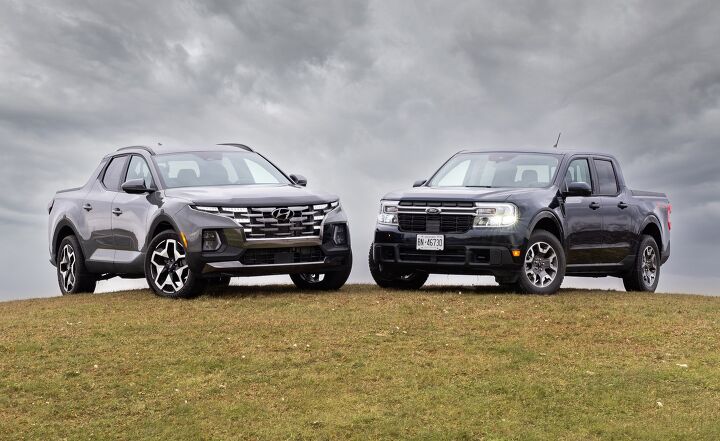



































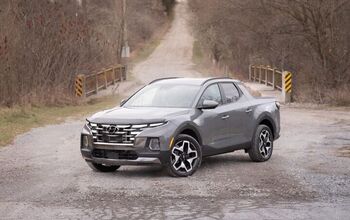
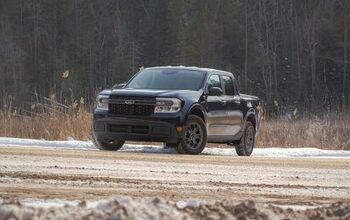

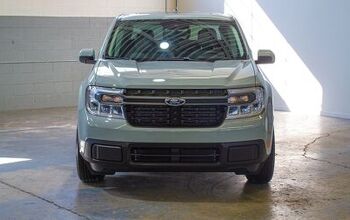





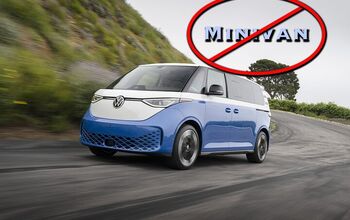
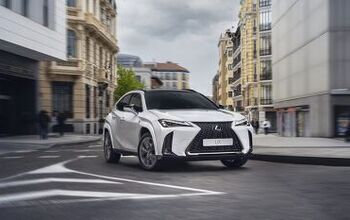

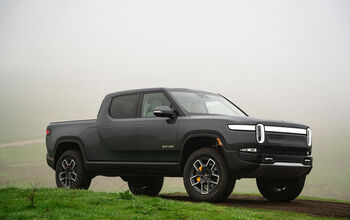


Comments
Join the conversation
they both missed the boat on a truck thats 1 affordable and 2 function. we went out to try to buy elther. neither tows squat,the hundi is almost enough, but the $$$ just do not do it. that should be the $20000. truck $21000 with turbo., the ord is also over priced and under power and way to low tow capability. so in the end what did we get??? nothing.Im not stupid enough to pay the prices the morons are paying for this crap. a small truck should be 1 usable,2 afordable. that fird should be around $15000~17000 with turbo.and atleasy 5500 pounds towing. shame on them for trying to give us this crap.and the electrick ford??what a joke.no towing execpt for bycycles.